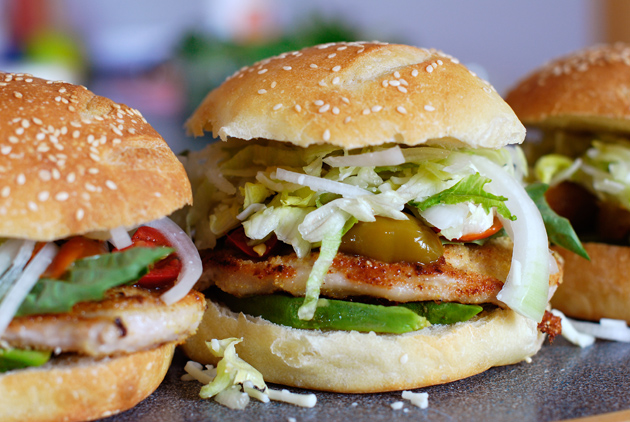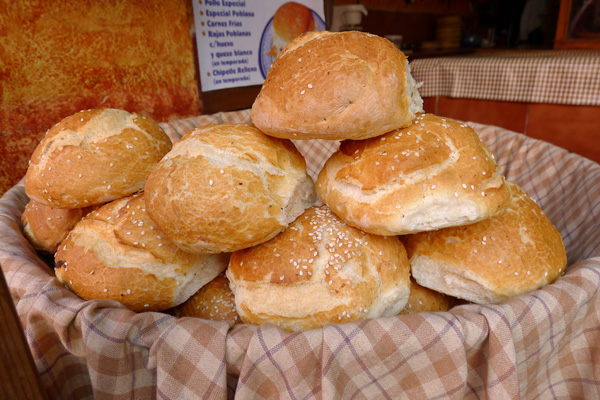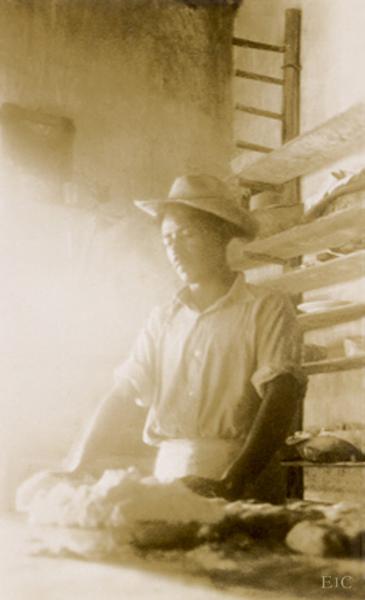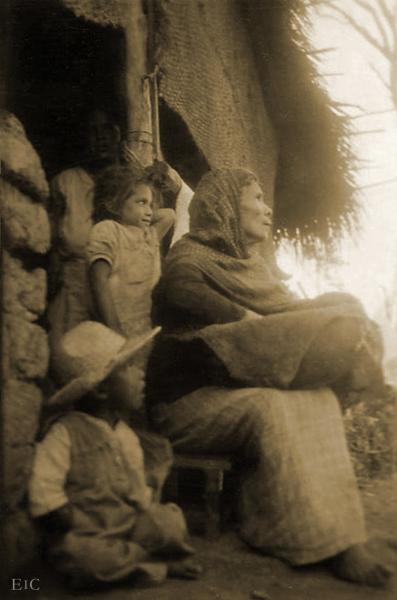A good sandwich deserves a good roll. Enter the Cemita, a slightly sweet bun that gives its name to a whole style of street food in Puebla, Mexico. Crackly thin crust on the outside, with a lightly firm but airy center, and fresh! - made every morning in just one bakery, following a closely guarded recipe.
So what would a Philly boy find so enticing about a Cemita? A beaten pork and avocado sandwich, piled with sweet marinated peppers and topped with strands of panela cheese, is certainly different from the cheesesteaks of my youth. And yet, there's something similar enough there, in the way it has grown with the city into a culinary icon best eaten locally. And as with the cheesesteak, a Cemita really is one great handful of a sandwich!
For a variety of reasons, I've taken liberties with the sandwich filling. Some real ingredients are impossible to find while others (like the quarter pound of cheese) I can do without. I have, however, made the recipe for the rolls very much like the real one. If you follow it closely and bake on a pizza stone or quarry tiles, your sandwiches will be the envy of the neighborhood. Enjoy!

Visit Sortachef at www.woodfiredkitchen.com to see the original post
Cemitas: Great Sandwiches from Puebla, Mexico
Recipe yields enough dough for 8 sandwich rolls
For the rolls:
12 ounces water at 100°
1½ teaspoons dry yeast
1½ teaspoons salt
2 teaspoons sugar
2 Tablespoons Spectrum shortening or lard
11 ounces (rounded 2 cups) unbleached all-purpose flour
1 egg
6 ounces flour (1¼ cup) flour for mixing
¾ cups flour for bench work
Water and sesame seeds to finish
For the filling (quantities per sandwich):
¼ ripe avocado
1 boneless pork chop, marinated in 1 teaspoon each vinegar and sugar, smashed with a hammer and coated with some masa harina or breadcrumbs
Oil for frying
Salt and pepper
A few sprigs of basil
2 marinated sweet cherry peppers
¼ cup shredded lettuce
White onion
Mozzarella cheese
Make the dough: Put 12 ounces warm water, the yeast, sugar, shortening, salt and 11 ounces of flour into the bowl of a stand mixer. Break in the egg. Whisk with a wire attachment for 5 minutes on medium speed until the dough is very smooth and has the consistency of a cake batter. Scrape down the sides of the mixing bowl as necessary.
Switch to the dough hook and add 6 more ounces of flour. Mix on low for a further 5 minutes or so to make a soft dough.
Turn the dough out onto a floured work surface and knead for 5 minutes or more. Put the dough into a big bread bowl and cover the bowl with plastic or a damp cloth.
First rise: 4½ hours at 65°. Punch down the dough, turn using a dough scraper, and let rise again.
Second rise: 3½ hours at 65°. I prefer at this point to put the dough in its bowl on ice packs overnight. Take away from the ice and punch the dough down early in the morning.
Shape the rolls: Shape the dough into a snake, and cut into 8 equal pieces, about 4.5 ounces each. Form into round doughballs, stretching the skin over the tops. Let rest for ½ hour, covered with a floured cloth.
Lightly butter a jelly roll pan or large cookie sheet. Flatten the dough pieces somewhat (to about 1" thick) and space them evenly on the tray. Let rest for a further ½ hour.
Preheat the oven: Turn oven to 450°. Use quarry tiles for best results. Set rack at the halfway point in the oven.
Finish and bake: Brush the top skin of the rolls with water, wait 2 minutes and then brush them again. Lightly sprinkle with sesame seeds.
Put the sheet pan directly on the hot quarry tiles and bake for 18 minutes, or until the skin on the rolls turns golden brown. Let rolls cool on a rack for an hour before filling.
To make the sandwiches: In a large frying pan fry the smashed pork chops one or two at a time in a Tablespoon of oil over medium high heat. Turned once, the chops will be cooked through in about 5 minutes or when browned on both sides. Salt and pepper to taste and leave chops to drain on paper towels.
Meanwhile, shred the lettuce and mix with some sliced onion and mozzarella cheese. Slice the avocado and sweet peppers.
Build sandwiches with (from the bottom up):
- Sliced avocado
- Smashed, breaded and fried pork chop
- Sprigs of basil
- Sliced sweet peppers
- Shredded lettuce, onion and mozzarella cheese
- Hot sauce, if desired
Final Note: At Cemitas Las Poblanitas, the cemitas café that takes up the whole northeast corner of the Mercado del Carmen in Puebla, more than 1000 cemitas are created every day. To sample an authentic cemita - in their case topped with about ¼ pound of cheese and finished with a slice of ham - do give them a shout if you're in the area. You'll be glad you did.
And if you happen to see my friends Alonzo and Lizbet sitting at one of the tables there, raise a beer to them. And tell them Sortachef says 'hi'!

Copyright 2010 by Don Hogeland. See original post at www.woodfiredkitchen.com













